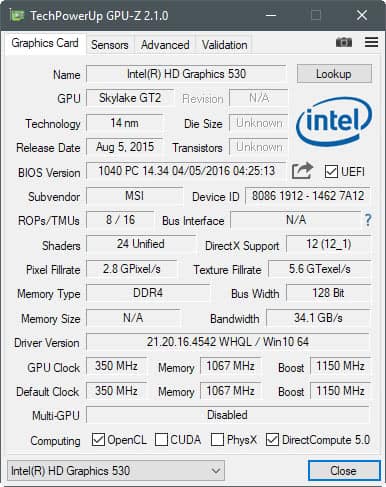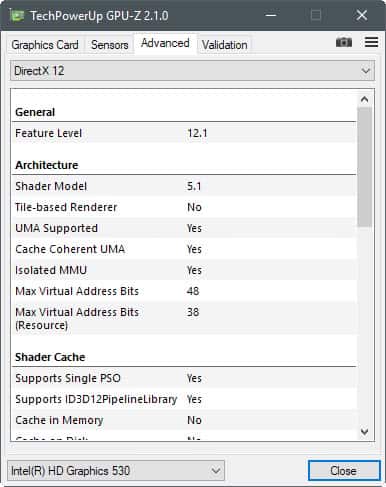GPU-Z 2.1 is the latest version of the popular lightweight and portable video card info tool for Microsoft Windows devices.
Tech Powerup, the company that develops GPU-Z released GPU-Z 2.0 earlier today, and pushed out GPU-Z 2.1 later today as well. This same-day update addresses various bugs in the new release.
The main new release is GPU-Z 2.0. It replaces the 1.x versions of GPU-Z, and introduces support for new hardware, and some new features to the application.
Downloads are as usually offered on the developer site. The standard version has a size of 4.4 Megabytes, and can be run either as a portable application, or installed on the system. Options to do so are displayed when you run the program.
A look at GPU-Z 2.1

The big new feature of GPU-Z 2.1 is the new advanced tab that has been added to the program. The program interface lists four tabs now of which the following three were available in previous versions as well:
- Graphics Card — This tab displays various information about the installed video card. Included are the name and GPU, release date, bios version, information on the pixel fillrate, memory type, shaders, clock speed, and computing support (OpenCL, CUDA, PhysX, DirectCompute).
- Sensors — Lists the GPU temperature, load, power, memory usage, as well as core and memory clock speed in real-time.
- Validation — Submit comments.
The fourth tab, Advanced, displays a menu on start but a blank screen otherwise.The menu lists options to display information on the following features: ASIC Quality, WDDM, DirectX 9, 10, 11, and 12, OpenCL, and Vulkan.

You may select one of the available features, to display a truckload of information on the screen. If you open DirectX 12 for instance, information on architecture, shader cache and capabilities are listed by the tool.
This can be quite useful, as it may help you determine whether a particular feature is supported by the installed video card.
You may save the information that GPU-Z displays to a file, or upload them directly to a video hosting site. The latter may be useful if you are in need of support, and were asked to upload the data to make it available publicly.
GPU-Z 2.1 ships with support for new hardware on top of that. Support was added for the following chipsets:
- NVIDIA Tesla P100 PCIe, Tesla M10, and Quadro P5000.
- Intel Graphics 615.
- AMD HD 8350G.
- EVGA ICX Sensors.
Several bugs were fixed in GPU-Z 2.1 as well, including DirectX support detection for ATI R600 and older video cards, and BIOS saving on GeForce 900 and newer series cards on 32-bit operating system versions.
Closing Words
GPU-Z is a well-designed, lightweight program for Windows that displays loads and loads of video card information. Useful if you just want to check out the capabilities of the video card (for instance to make sure the right one is built-in to the device, are a developer, or like to overclock/underclock your hardware.
Now You: Do you use hardware information tools? If so which?